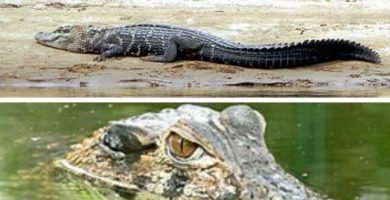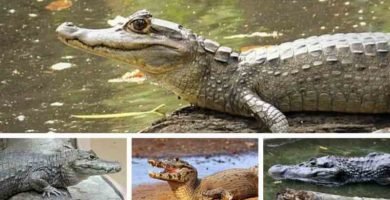
Characteristics, what does the white caiman eat?, reproduction, behavior, geographic distribution.
Caiman crocodilus is known as the white caiman, white lizard, spectacled caiman, baba, babilla, yacaré-tingas, and yurá-lagarto.
Four subspecies of this species have been recognized: C. c. crocodilus, C. c. chiapasilus, C.c. fuscus, C.c. apaporiensis (Ortiz, Carvajal-Campos-Rodríguez-Guerra 2010).
Characteristics of the white caiman
One of the most notable characteristics of the white caiman or caiman crocodilus, and which gives it the name of spectacled caiman, is the presence on the head of a crescent-shaped ridge in front of each eye, located on the dorsum of the snout.
This caiman has an olive-brown to yellowish color on the back and a cream or whitish color on the belly.
This species is widely distributed in fresh waters throughout the Americas. It is nocturnal, although it is sometimes found receiving sun during the day.

What does the white caiman feed on?
It is often gregarious, and usually accompanied by other caimans. It is a generalist carnivore, and feeds on fish, waterfowl, mammals, frogs and lizards.
It presents secondary sexual dimorphism, especially because males are larger than females.
Reproduction
The male mates with the female in the water. The female immediately makes a nest in the leaf litter, near the rivers or lagoons where she lives. There, the female deposits 28 to 40 eggs, with an incubation period of 70 to 90 days. It exhibits maternal parental care.
After the hatching of the eggs, the mother moves her young to the water, carrying them in her mouth, and then keeping them in shallow water. The female cares for her young for up to several months.
In the hatchling state, the young are very vulnerable to predation by lizards, mammals, aquatic birds, some fish (such as piranhas), and jaguars. Later, as adults, the white caiman’s only predators are the jaguar and the anaconda.
Behavior of the white caiman

gailhampshire from Cradley, Malvern, U.K / CC BY
Specialists say that caimans, contrary to popular belief, are reptiles that prefer to evade and hide in the face of any threat. But they defend their territory, communicating with other caimans through auditory, visual and chemical signals.
It is a species of terrestrial and freshwater habits, adapting relatively easily to different types of ecosystems.
In some areas, for example in the Ecuadorian Cuyabeno Reserve, white caimans overlap with black caimans, showing sympatric capacity, that is, they share the same geographic region without presenting major problems of coexistence.

Dr. Rafael Cartay is a Venezuelan economist, historian, and writer best known for his extensive work in gastronomy, and has received the National Nutrition Award, Gourmand World Cookbook Award, Best Kitchen Dictionary, and The Great Gold Fork. He began his research on the Amazon in 2014 and lived in Iquitos during 2015, where he wrote The Peruvian Amazon Table (2016), the Dictionary of Food and Cuisine of the Amazon Basin (2020), and the online portal delAmazonas.com, of which he is co-founder and main writer. Books by Rafael Cartay can be found on Amazon.com
More about Amazon caimans
April 22, 2020

Black Caiman – A rare crocodile species
April 20, 2020

Caimans – Top Three Amazon Rainforest Crocodiles
This post is also available in:
![]() Español (Spanish)
Español (Spanish)
